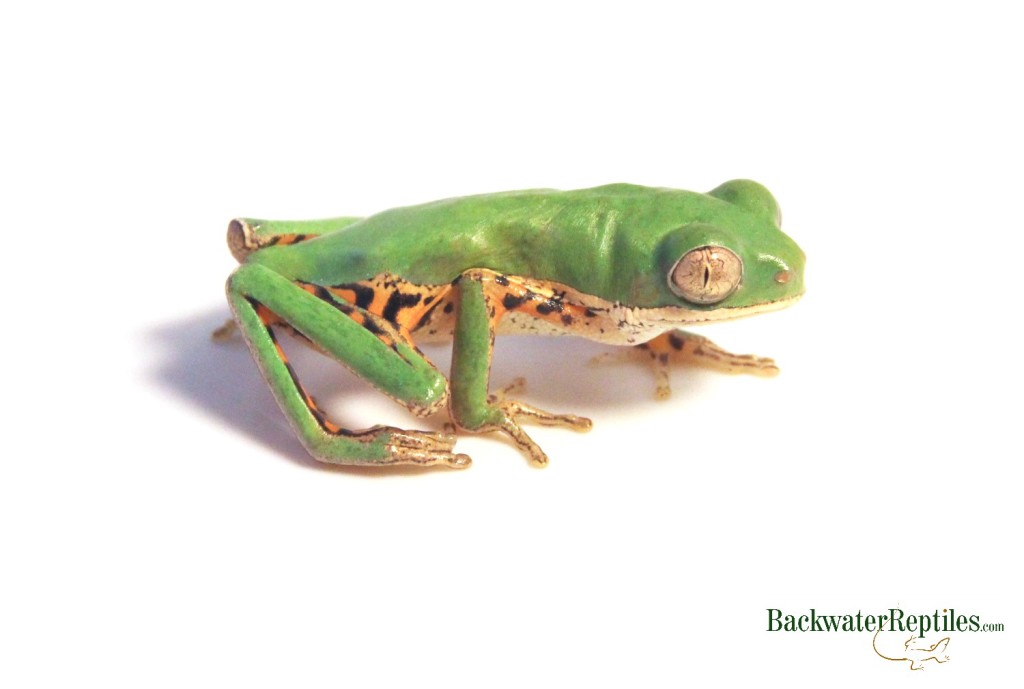Looking for a Tiger leg tree frog care sheet? Many species of tree frogs are visually striking and colorful, but in our opinion, one of the neatest looking tree frogs is the Tiger leg tree frog (Phyllomedusa hypochondrialis).
We recommend tiger leg tree frogs as a pet for anyone who wants a flashy frog that they can show off to friends and family.
Read on to find out more about how to care for this tropical tree frog.
Tiger Leg Tree Frog Care
Tiger Leg Tree Frog Description
As we’ve already established, tiger leg tree frogs are definitely dazzling when you first see them. They have long, lean, lanky bodies and limbs with arresting, cat-like eyes with vertical pupils. But of course, the most stand-out feature of this tree frog is its bright orange sides and feet complete with black tiger-esque stripes or bars. Overall, the appearance of the tiger leg tree frog is impressive and memorable. We guarantee your friends will be amazed by this frog’s unique physical traits.
Due to their noctural lifestyle, tiger leg tree frogs sleep during the day. However, at night, they are quite active and you will be able to observe your frog eating, soaking in its water dish or bowl, and climbing around its enclosure. If you’re lucky enough to get a male tiger leg tree frog, you will also likely hear your frog vocalize at night.

Tiger leg tree frogs are slow movers and tend to amble along rather than jump, although when they do, it’s with quite a powerful force and they can go quite far. This means that you will likely be safe to handle your frog during the day since it will be sleepy and more than likely just sit comfortably in the palm of your hand. Keep in mind though that frequent interaction with humans for any species of frog can prove stressful, so even if your tiger leg tree frog is friendly, we do recommend keeping the handling to a minimum just for the safety of this delicate frog species.
Tiger Leg Tree Frog Care: Habitat
Tiger leg tree frogs hail from the Amazonian rainforest and therefore require a tropical habitat.
When keeping a single frog, we recommend starting off with a standard glass tank with a screen top lid. Unless you are keeping more than six frogs, a twenty gallon tank will suffice. Your substrate can be as simple as moist paper towels, which will need to be changed regularly, or you can go with something more aesthetically pleasing like padded down sphagnum moss.
Your frog will enjoy having itself a nice little soak from time to time, so provide a water dish that is large enough to accomodate this behavior. In addition, you will want to make sure there are plenty of perches and/or plants to climb on inside the tank. Tiger leg tree frogs are arboreal, so they will spend quite a bit of time in the foliage or perches provided, especially during the day when they will be sleeping.

Because they are nocturnal and have clear schedules, you should provide a photo period that replicates natural daylight hours. Keep a low strength light over one side of the enclosure that stays lit for ten to twelve hours daily.
The ambient temperature in the enclosure should stay between 75 and 82 degrees Fahrenheit. You will also need to mist the enclosure at least once per day to keep the substrate moist and the humidity level around 50 to 80%.
Tiger Leg Tree Frog Care: Feeding
Like a typical tree frog, the tiger leg tree frog is an insectivore and will gladly eat virtually any insect you give it.
At Backwater Reptiles, we feed our tiger leg tree frogs gut-loaded crickets, mealworms, roaches, and sometimes wax worms for treats.

Make sure that you offer your frog food at night when it will be active and ready to eat.
Juveniles should eat every day whereas adults can eat a few insects every other day.
Conclusion – Tiger leg tree frog care
Tiger leg tree frogs are fascinating and colorful pets. If you want a frog that you can enjoy showing off, a tiger leg tree frog just might be for you! We did our best detailing the care requirements of this tropical beauty, and we hope you found it useful.
